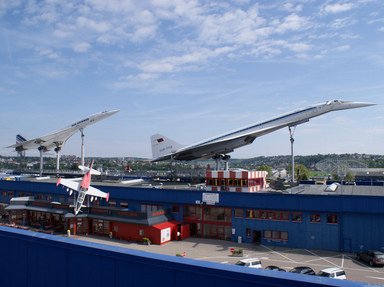Quiz Answer Key and Fun Facts
1. The Tupolev Tu-144's development initially ran for seven years, from the first publication of the concept in 1962, to the first flight of the prototype in 1968 from which of Moscow's airports?
2. The treaty between the UK and France to develop a Supersonic Transport saw two companies initially named as prime contractors. The British Aircraft Corporation (BAC) was one, but which French firm was the other?
3. During the Tu-144's development, the design of its wing required testing. To achieve this, a scale version of the planned wing design was fitted to an example of which Soviet fighter aircraft?
4. The name of the Anglo-French aircraft was chosen to reflect the agreement between the two countries. However, it was only in 1967 that the French spelling was confirmed as the aircraft's name, with UK Technology Minister Tony Benn soothing Anglophone sensibilities by stating that the 'e' stood for various concepts. Which of the following was not one that he mentioned?
5. In 1973, the Tu-144 followed Concorde in a flying display that led to it suffering a fatal crash. At which air show did this occur?
6. Three airlines were the original launch customers for Concorde. Air France and BOAC were two, but which was the third?
7. The Tu-144 entered passenger service with Aeroflot in November 1977. Its first passenger route was between Moscow and which other Soviet city?
8. British Airways and Air France began Concorde operations in January 1976. Air France operated a service between Paris and Rio de Janeiro via Dakar, while British Airways ran between London and which Middle Eastern country?
9. In 1978, the Tu-144 was withdrawn from passenger service, being replaced on its one passenger route, as well as the others it was planned for, by the Soviet Union's first wide-body airliner. From which design bureau did it originate?
10. Between 1978 and 1980, Braniff International Airways entered into agreements with both Air France and British Airways to use Concorde on domestic flights in the United States to which airport?
11. British Airways' operation of Concorde is synonymous with the United States. Which of the following US cities never had a regularly scheduled Concorde service run by BA?
12. For four years from 1978 to 1982, Air France ran scheduled Concorde services to which other city in North America?
13. After the start of British Airways' Concorde services, which other UK airline investigated the possibility of obtaining the aircraft to run its own supersonic operations?
14. The last day of Concorde operations in October 2003 saw three British Airways flights land successively at Heathrow Airport. One was the final scheduled service, while a second had flown from London to Edinburgh and back. The third was a trip around which sea area?
15. Only one Tu-144 is displayed outside the former Soviet Union, and this is the only instance of both SSTs being on display together. In which European country can you see Concorde and Concordski side by side?
Source: Author
Red_John
This quiz was reviewed by FunTrivia editor
stedman before going online.
Any errors found in FunTrivia content are routinely corrected through our feedback system.
